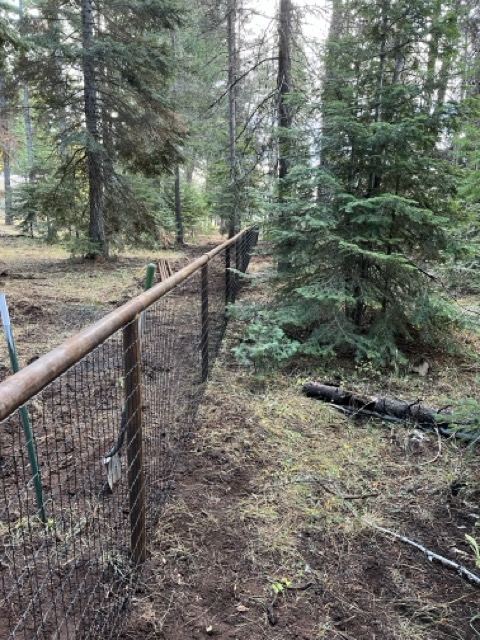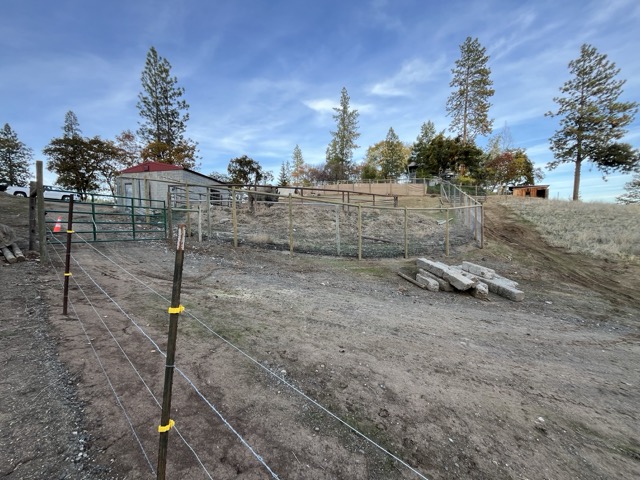Seasonal Fencing Tips: Preparing Your Farm for Winter and Beyond
A Blog by Cascade Fencing
Keep Your Farm Ready for Any Season
Agricultural fencing is an essential part of managing a farm. Whether you’re containing livestock, protecting crops with cedar fencing, or establishing property boundaries, your fence needs to be reliable year-round.
However, the changing seasons can significantly impact the performance and durability of your fencing. From heavy snow in winter to dry heat in summer, each season presents unique challenges that require careful preparation and maintenance.
In this blog, we’ll explore seasonal fencing tips to help you protect your investment, extend the life of your fence, and ensure your farm operates smoothly no matter the time of year.

Winter: Protecting Your Fence from Snow and Ice
Winter brings freezing temperatures, heavy snow, and ice buildup—all of which can put stress on your fencing materials. Here’s how to prepare your fence for winter:
Inspect and Repair Before the First Snowfall
- Check for Weak Spots: Inspect posts, wires, and rails for any signs of damage or wear. Repairing these areas before winter prevents small issues from becoming major problems when snow adds extra weight.
- Reinforce Posts: Ensure all posts are securely anchored in the ground. Frost heave, a phenomenon caused by soil expanding as it freezes, can dislodge posts and weaken your fence.
- Tighten Wires: For wire fences, ensure that all wires are properly tensioned. Sagging wires are more susceptible to damage from snow and ice.
Remove Snow and Ice Build-Up
- Clear Accumulated Snow: Heavy snow can weigh down wire and chain link fences, causing sagging or bending. Regularly remove snow from your fence to prevent structural damage.
- De-Ice Gate Areas: Gates can freeze shut during the winter, making it difficult to access your property. Use a safe de-icing solution to keep gate latches and hinges operational.
Protect Against Moisture Damage
- Seal Wooden Fences: Apply a water-resistant sealant to wooden fences to prevent moisture from seeping in and causing rot. This is especially important for cedar fencing and untreated wood.
- Inspect Metal Fences for Rust: Metal fences, such as chain link or barbed wire, should be treated with a rust-resistant coating to protect against corrosion caused by snow and ice.
Spring: Repairing Winter Damage and Preparing for Growth
As the snow melts and the ground thaws, spring is the perfect time to assess any damage caused by winter and prepare your fence for the upcoming grazing season.
Assess Winter Damage
- Inspect Your Fence: Walk along your fence line and look for broken posts, sagging wires, or damaged rails. Pay close attention to areas where snow may have piled up or ice accumulated.
- Repair Weak Points: Replace broken posts and re-tension sagging wires. For wooden fences, check for rot or splitting and replace affected boards as needed.
Clear Fence Lines
- Remove Debris: Winter storms often leave branches, leaves, and other debris along your fence line. Clearing this debris reduces pressure on your fence and prevents damage.
- Trim Vegetation: Overgrown vegetation can interfere with electric fences, causing shorts or reducing their effectiveness. Trim grass, shrubs, and tree branches near your fence line.

Recheck Gates and Latches
- Ensure Functionality: Gates and latches may have warped or loosened during the winter. Test all gates and make necessary adjustments to ensure smooth operation.
Plan for Livestock Rotation
- Evaluate Fencing Needs: If you plan to rotate your livestock to different pastures, ensure that all fencing is in good condition and suitable for containment.
Summer: Protecting Against Heat and Dry Conditions
While summer may seem less demanding for fencing, dry heat and increased livestock activity can still cause wear and tear. Here’s how to keep your fence in good shape during the hottest months.
Inspect for Warping and Cracking
- Wooden Fences: Prolonged exposure to intense sunlight can cause wooden fences to warp or crack. Inspect for signs of damage and reapply sealant to protect against drying.
- Wire Fences: High temperatures can cause wire fencing to expand, leading to sagging. Check wire tension regularly and adjust as needed.
Maintain Vegetation Control
- Prevent Overgrowth: Summer is a time of rapid plant growth, which can interfere with electric fencing or weaken cedar fencing lines. Regular mowing and trimming keep your fence clear and functional.
Check for Loose Posts
- Soil Shifting: Dry, loose soil can cause posts to become unstable. Ensure that posts are securely anchored, especially in areas with sandy or clay-rich soil.
Protect Against Wildlife and Livestock Wear
- Monitor Animal Activity: Increased livestock activity during grazing can stress fences, especially if animals lean or push against them. Reinforce weak areas and ensure electric fences are functioning to discourage contact.
- Deter Wildlife: Summer brings increased wildlife activity. Inspect your fence for breaches caused by deer or other animals and make necessary repairs.
Fall: Preparing for the Upcoming Winter
As temperatures begin to drop, fall is the ideal time to prepare your fence for the challenges of winter. Taking proactive steps now can save you time and money in the colder months.
Conduct a Comprehensive Inspection
- Evaluate Durability: Look for signs of wear and address issues before winter arrives. Focus on areas that experience heavy use, such as gates and corners.
- Check Fasteners: Ensure that nails, screws, and other fasteners are secure. Loose fasteners can lead to structural issues when snow and ice accumulate.
Reinforce and Upgrade
- Add Reinforcements: Install additional supports or bracing for fences that may struggle to handle heavy snow loads.
- Upgrade Materials: If your current fencing materials are nearing the end of their lifespan, consider replacing them with more durable options like high-tensile wire or treated cedar fencing.
Prepare Fence Lines
- Clear Vegetation: Trim back plants and trees to minimize the risk of branches falling onto your fence during winter storms.
- Mark Fence Lines: Use reflective markers or brightly colored tape to make fence lines more visible in snowy conditions. This is especially helpful near gates and access points.
Year-Round Fencing Maintenance Tips
While each season requires specific maintenance tasks, there are some general practices that apply year-round to ensure your fence remains in top condition.
Regular Inspections
Make it a habit to inspect your fence at least once per season. Addressing small issues promptly can prevent more significant problems down the line.
Proper Cleaning
Keep your fence clean and free of debris. For wooden fences, remove dirt and mildew with a mild detergent. For metal fences, use a wire brush to remove rust and apply a protective coating.
Professional Assistance
For large-scale repairs or installations, consider hiring a professional fencing contractor. Their expertise ensures that your fence is built to last and tailored to your farm’s specific needs.
Choosing the Right Materials for Seasonal Durability
The type of fencing material you choose plays a significant role in how well your fence withstands seasonal changes. Here are some recommendations:
Wooden Fencing (Cedar Fencing, Treated Pine)
- Ideal for farms that prioritize aesthetics and privacy.
- Naturally resistant to pests and decay, especially when sealed.
- Requires regular maintenance to protect against weathering.
Metal Fencing (Chain Link, High-Tensile Wire)
- Durable and resistant to weather extremes.
- Low maintenance, with excellent longevity when treated for rust resistance.
- Suitable for large properties or heavy livestock use.
Electric Fencing
- Versatile and easy to install.
- Requires regular monitoring to ensure functionality.
- Ideal for rotational grazing and temporary fencing needs.
How Seasonal Changes Affect Different Fencing Materials
Each fencing material responds differently to seasonal weather conditions, making it essential to choose the right material for your farm’s environment. Understanding how these materials perform in various seasons can help you prepare and maintain your fence effectively.
Wooden Fencing (Cedar Fencing, Treated Pine)
- Winter: Moisture from snow and ice can seep into untreated wood, causing it to swell and potentially crack when temperatures drop. Sealing your wood before winter can prevent water damage.
- Spring: As the ground thaws, frost heave can loosen wooden posts. Inspect your posts and reset any that have shifted during winter.
- Summer: Intense sunlight can dry out wood, leading to warping or splitting. Applying a UV-resistant stain or sealant can help maintain its integrity.
- Fall: Wet leaves and debris accumulating around wooden posts can promote rot. Clear away vegetation to protect the base of your fence.
Metal Fencing (Chain Link, Barbed Wire)
- Winter: Metal fences are prone to rust when exposed to moisture and salt. Applying a rust-resistant coating can prevent corrosion during the snowy months.
- Spring: Check for sagging or bent wires caused by snow load. Tighten or replace wires as needed.
- Summer: Metal expands in high heat, potentially loosening connections. Inspect tension points and ensure they’re secure.
- Fall: Falling leaves and debris can accumulate around the base of the fence, trapping moisture. Regular cleaning is crucial to avoid long-term damage.
Electric Fencing
- Winter: Snow and ice can interrupt the electrical current. Keep the fence line clear and check the power supply regularly.
- Spring: Vegetation grows quickly during spring and can short out electric fences. Trim surrounding plants to maintain effectiveness.
- Summer: Dry conditions can reduce grounding efficiency. Ensure that the grounding rods are deep enough to maintain a strong charge.
- Fall: Wet autumn conditions can enhance conductivity but also increase the risk of shorts from wet debris. Inspect the system thoroughly.
By tailoring your maintenance approach to the material and season, you can maximize the lifespan and effectiveness of your fence.
Benefits of Proactive Fencing Maintenance
Taking a proactive approach to fencing maintenance offers numerous advantages, helping you avoid costly repairs, protect your livestock, and maintain the overall functionality of your farm.
Cost Savings
Regular maintenance prevents small issues from escalating into major problems. Repairing a single broken post or tightening a loose wire is far less expensive than replacing an entire section of fencing. Additionally, well-maintained cedar fencing reduce the risk of livestock escapes, which can lead to financial losses.
Improved Livestock Safety
A strong, secure fence keeps your animals safe by preventing them from wandering into hazardous areas or falling prey to predators. Proactive maintenance ensures there are no weak points for animals to exploit, reducing the likelihood of injuries or escapes.
Increased Fence Longevity
Fences that receive consistent care last significantly longer than those left unattended. By inspecting and addressing issues like rust, rot, or tension loss, you can extend the lifespan of your fence and delay the need for costly replacements.
Enhanced Farm Productivity
A reliable fence simplifies farm management by keeping livestock where they belong and protecting crops from damage. This allows you to focus on other tasks without constantly worrying about your fencing’s condition.
Seasonal Preparedness
Proactive maintenance helps you prepare for seasonal challenges, from winter snow to summer heat. By addressing potential vulnerabilities ahead of time, you can avoid emergencies and maintain peace of mind throughout the year.
Tips for Proactive Maintenance
- Create a Schedule: Conduct inspections at the start of each season and after major weather events.
- Prioritize Repairs: Address high-risk areas, such as gates, corners, and heavily trafficked sections, first.
- Invest in Quality Materials: Using durable materials reduces the frequency of repairs and the likelihood of failure.
By committing to proactive maintenance, you protect your investment and ensure your fence continues to serve its purpose effectively year-round.
Protecting Your Farm with Seasonal Fencing Care
Proper fencing is a vital part of farm management, and taking seasonal challenges into account ensures that your fence remains effective year-round. By following these tips and staying proactive, you can extend the lifespan of your fence, protect your livestock, and save money on repairs and replacements.
If you’re ready to upgrade your fencing or need professional assistance, Cascade Fencing is here to help. From cedar fencing to chain link fencing in Prineville, OR, our team provides high-quality, durable solutions tailored to your farm’s unique needs. Contact us today to learn more about our services and keep your farm secure through every season.


